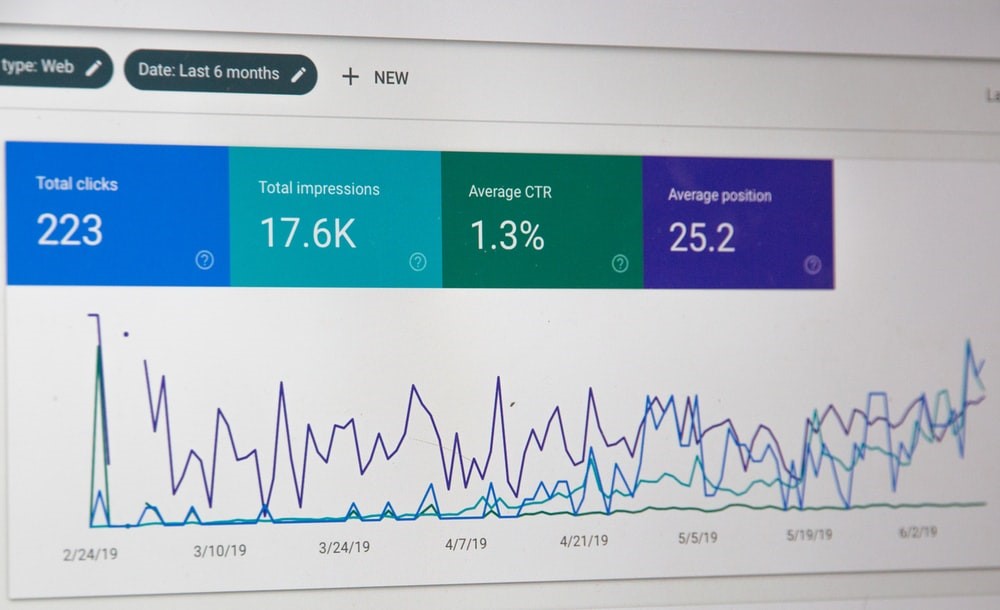SEO does not yield immediate results. You start with on page and technical SEO and move on to building links all the while monitoring your traffic and rankings and finally start seeing some serious results in six to eight months.
At least that’s how it goes for websites with decent competition out there. For websites that have little to no competition, you can move the needle relatively quick, but with most websites, you need to establish some KPIs that you can monitor weekly or monthly just to see if you are on the right track.
In this article, we will discuss such KPIs.
What’s the ultimate goal of SEO?

With the help of SEO, most websites aim to achieve the following:
- Increased visibility and online presence (measured in the ‘impressions’ in the search console)
- Improved traffic (measured in ‘new visitors’ or ‘sessions’ in analytics)
- Direct increased revenue (in the form of eCommerce transactions)
- Indirect increased revenue (in the form of leads)
To have a chance at achieving any of that, you have to make it to page one for relevant keywords.
All your SEO efforts are directed towards that goal. For most websites, that goal is achieved after months and months of hard work. During said months, you can use the following KPIs to make sure you are on the right track:
3 KPIs To Check If SEO Strategy is Working

1. Track Keyword Rankings
Rank tracking is one of the most common methods of measuring your performance as an SEO and making sure your SEO strategy is working.
You first create a list of keywords you want to rank for, during the keyword research phase, and establish a baseline by putting it in a rank tracker and getting your week 1 ranks.
From then onwards, you should keep track of your keywords every week and see which keywords are rising through the ranks and which are dropping. Analyzing rank tracker data will give you a lot of insight into different aspects of your SEO strategy and whether or not they are working.
You can do a collective analysis and keep an eye on the overall trend, and you can also track individual keywords separately to see which keywords are doing better than the others. Doing weekly analysis also allows you to monitor the impact of your SEO efforts in almost real time.
For example, you worked on improving page load speed and got it to three seconds from sixteen seconds. Theoretically, this should have an impact on your keyword rankings and your rankings should improve.
Similarly, backlinks from high quality sites should have a rather quick effect on your website’s rankings. Tracking allows you to adjust your strategy, experiment a bit, and identify the elements of your strategy that need to improve.
2. Keep Track of Your Backlink Profile
Your backlink profile constantly needs to be growing in quality, which is to say that higher quality websites should be linking to you constantly.
You can always do a weekly check on your link profile and see if your link profile is improving. Ideally, you should be getting additional links every week as a result of your outreach efforts.
It is also a good idea to keep an eye on the backlink profile of your direct competitors and see where you stand.
If you are inching closer and closer to their number of links, and your links are of a similar of better quality, you are on the right track.
3. Organic Sessionsand Average Session Duration
You can get data on both of these KPIs via Google Analytics. The number of organic sessions you get every month can arguably be a better indicator of your SEO performance as compared to the number of users you get.
It is pretty common for SEO agencies to prefer organic sessions as a key performance indicator. The number of users you get will always be higher than those who actually spend time on your website, but those who browse multiple pages and spend more than a few second on your site are more likely to return, fill out a form, make a purchase or perform the action you want them to perform. As such, if your number of organic sessions is increasing month after month, you are on the right track.
I have lumped average session duration and organic sessions together because they go hand in hand. In an ideal situation, the number of organic sessions should have a directly proportional relationship with average session duration.
Measured in seconds and minutes, average session duration tells you how much time your visitors are spending on your website. This is an important indicator because you can get your ranking and traffic up, and subsequently your visitors and sessions, but if you can’t get them to stay, your rankings will soon start dropping.
You will then need to dive into why your average session duration is going down and work with the rest of the marketing team to improve the user experience on the page.
With the help of your developer, content writer, and designer, you should be able to improve the pages that lose traffic and are bringing your rankings down.
These are some of the key SEO metrics to measure as you work on a website and try to get it to page one. After you get to page one for your target keywords, you will probably want to keep monitoring those but rely on traffic, leads, and revenue as the main KPIs.
You May Like To Read:
- The New Guide to SEO Optimization – Focusing on What Google Wants in 2020
- Why You Should Spend a Good Penny on High-End SEO Solutions
- How To Use SEO To Drive Traffic & Generate Sales?
- A Complete SEO Strategy Template: Why Your Business Needs SEO
Author Bio: Andrew Wilson is an SEO analyst at Rank Genie. He loves to watch movies, listen to podcasts, and plan about launching his own podcast. He has helped the Rank Genie team shape their rank tracker and make it one of the most easy-to-use and SEO friendly trackers out there. You can find his blogs on RankGenie.














